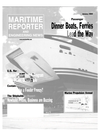
Page 32: of Maritime Reporter Magazine (January 2004)
Ferry & Passenger Vessel Yearbook
Read this page in Pdf, Flash or Html5 edition of January 2004 Maritime Reporter Magazine
U.S. Navy's AEGIS Cruiser Modernization Program:
Adding Co tib at Power; Extending Ship Life
The guided missile cruiser USS Antietam (CG 54) approaches the port side of the guided missile frigate USS Ingraham (FFG 61) during a leap frog training exercise. The exercise allows ship han- dlers to practice the approach and stabilization alongside and a breakaway in a simulated under- way replenishment environment. Ingraham and
Antietam are part of the USS Carl Vinson (CVN 70) Carrier Strike Group on deployment in the
Western Pacific Ocean. U.S. Navy photo by
Photographer's Mate 2nd Class Jeremie Kerns. will ensure increased combat power throughout their service lives. Our analysis was modeled to pace the threat through 2025," said Cmdr. Dave
Matawitz. branch head for Current
Ships in the Navy's Surface Warfare directorate.
Cruiser modernization will provide both a computing technology and force structure bridge to future ships.
Matawitz said.
The first ship scheduled to undergo cruiser modernization is USS Cape St.
George (CG-71), with the work com- mencing in FY 06. The final ship will begin modernization in FY 14.
The first five ships in the class, known as Baseline 1. did not receive the verti- cal launch system upgrade and will not receive the modernization. The lead ship of the class, USS Ticonderoga, is now 20 years old, and will be decom- missioned next year. USS Thomas S.
Gates (CG-51) was commissioned in 1987 and will be retired in FY 06.
The remaining baseline 2, 3 and 4 cruisers have varying capabilities. The cruiser modernization program will result in all remaining 22 ships having a common warfighting baseline.
The combat systems included in
Cruiser Modernization program involve weapons, combat direction and informa- tion processing systems. The ships will receive the AEGIS Baseline 7 Phase 1C computer program and Q-70 consoles with enhanced radar and computer dis- plays. _ J — . -
By Edward H. Lundquist
The U.S. Navy's "Cruiser
Modernization" program will extend the service life and enhance the combat capability of 22 of the Navy's 27 multi- mission AEGIS cruisers (CG-52 through
CG-73).
The Cruiser Modernization is neces- sary to enable the CG-47 class to partic- ipate effectively in support of joint lit- toral campaigns. Missions include land attack, littoral undersea warfare, force protection, and anti-air defense, as well as allowing for a possible future
Ballistic Missile Defense (BMD) mis- sion. The program extends the service life of each ship to 35 years. Combat systems will be upgraded while crew size and maintenance requirements will be reduced.
The program ensures the availability of air defense cruisers to support fleet operations until the new CG (X) cruiser joins the fleet in 2018.
The effort will significantly improve these ships' air dominance, force protec- tion. surface fires support and littoral undersea warfare capabilities. "We pro- tect the force. We provide assured access anywhere, anytime. And we project power over land," said Rear
Adm. Harry Ulrich, the Director of
Surface Warfare. "To do this, we must focus on readiness, recapitalization and revolutionary systems." "The various upgrades to the cruisers 32

 31
31

 33
33
